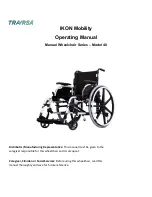
1-6
TR/YR Owners Manual
OM_TR_0712RevC
CHAPTER 1: WARNINGS
E. DESCENDING A FLIGHT OF STAIRS
I
WARNING
DO NOT descend a flight of stairs with the user in the wheelchair.
However, TiLite recognizes that wheelchair users may, on occasion, have no other choice. Only if you have no
alternative, you should follow these steps to descend a flight of stairs.
1. NEVER attempt to negotiate more than one step unless you have two (2) able-bodied adult assistants.
2. ALWAYS position the chair and rider facing down the stairs, with one assistant at the rear (facing down the stairs)
and one at the front of the chair (facing the rider).
3. The assistant at the rear of the chair is in control of this procedure. He or she must tilt the chair back to its balance
point on the rear wheels and roll it to the edge of the first step. NEVER attempt to lift a wheelchair by lifting on any
removable (detachable) parts, including upholstery and removable push handles or push handle grips.
4. The second assistant at the front must stand at the third step from the top and firmly grasp a non-detachable part
of the front frame (but NOT swing-away hangers) with both hands. The second assistant must lower the chair one
stair at a time by letting the rear wheels roll over the stair edge. Each assistant then carefully moves down to the
next stair.
5. Repeat steps 1 through 4 for each stair, until you reach the ground level.
6. When you reach the ground level, the first assistant should carefully lower the front casters to the ground.
If you ignore these Warnings, you may fall, tip over or lose control of the wheelchair and seriously injure yourself or
others or damage the wheelchair.
WARNINGS REGARDING FALLING AND TIPPING OVER
A. CENTER OF GRAVITY—STABILITY AND BALANCE
I
WARNING
Most falls or tip-overs occur when you go beyond the center of gravity of you and your wheelchair. TiLite wheelchairs
are designed to remain stable and upright in normal daily use and activities so long as you do not exceed the center of
gravity.
Every movement you make in your chair, and the rapidity with which you move, will have an affect on your center of
gravity. The more you shift your body weight and the greater the speed at which you shift it, the greater the impact on
your center of gravity in your chair.
There is a point where your wheelchair will tip forward or backward or to the side—which is a function of your center of
gravity in the chair—its center of balance and stability. The type of chair, the setup of your chair, the options on your
chair and the changes you make to the setup or options will all affect the center of gravity and therefore the stability of
the chair. As the stability decreases, the risk of a fall or tip-over increases.
Set forth below is a list of various types of adjustments that you may be able to make to your wheelchair, depending
on the wheelchair model you own, and a brief description of how those adjustments will affect your center of gravity:
1. The position of the rear wheels is the most significant factor affecting your center of gravity. The more you move
the rear wheels forward, the more likely your chair will tip over backward.
2. The distance between the rear wheels. The less distance between the rear wheels, the greater the likelihood your
chair will tip over to the side.
3. The amount of rear wheel camber. The less camber, the greater the likelihood your chair will tip over to the side.
















































